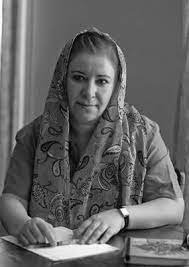
Last Update
May 2, 2021
Organisation
Iranian Writers’ Association
Gender
Female
Ethnic Group
Persian
Religoius Group
Shia
Province
Tehran
Occupation
Artist
Sentence
No sentence
Status
Released
Institution investigating
Ministry of Intelligence
Charges
Unknown
Date of Birth
28/6/1956
Place of Birth
Tehran
Fereshteh Sari Released
Fereshteh Sari studied computer science at Shahid Beheshti University of Tehran (formerly known as Melli University) and Russian language and literature at the University of Tehran.
She later turned to poetry, writing and translation. She has experienced being a mathematics teacher, researcher, editor and architect since 1979.
Fereshteh Sari's first book was a collection of poems titled "Echoes of Silence" which was published in the 1980s. She has collaborated with the literary publications "Gardoun", "Donya-ye Sokhan" and "Karnameh" and written and translated 17 books of poetry and stories.
The Armenian bus incident, in which Sari was caught up, was part of the Chain Murders of Iran and took place on August 6, 1996. The Ministry of Intelligence in the government of then president Akbar Hashemi Rafsanjani intended to kill a large number of Iranian cultural figures and send them all to the bottom of a valley.
The opportunity arose when the Writers' Association of Armenia invited members of the Iranian Writers' Association to travel to Armenia for a three-day poetry and cultural conference. At the time, flights between Tehran and Yerevan took place only once a week and it was not possible for the travelers to stay for a week. The group therefore traveled by bus. Ghaffar Hosseini, a member of the Iranian Writers' Association, became suspicious at the time and expressed his concerns bluntly, saying that "They are going to send you all to the bottom of the valley," but others ignored him.
Twenty-one cultural figures, including Mohammad Ali Sepanlou, headed for Armenia on a bus driven by Khosrow Barati, who was later identified as an agent of the Iranian Ministry of Intelligence. According to Mansour Koushan, another passenger, close to dawn passengers realized that the bus had stopped at one of the turns and the driver was not behind the wheel. He was standing a small distance away outside the bus. He told them that he had fallen asleep, become afraid and disembarked the bus.
The writers then remembered Ghaffar Hosseini's prediction. Despite their strong fear, they decided to continue but to have two people sit near the driver to monitor him. After moving about four meters, the driver sped up, turned the bus towards the edge and jumped out of th vehicle. But the passenger Masoud Toofan immediately took the wheel and another passenger, Shahriar Mandanipour, pulled the handbrake to stop the bus at the edge of the abyss.
In a story published in the Aftab-e Emrooz newspaper on November 11, 1999, Masoud Toofan said that after the bus was stopped, the driver returned and claimed that he had gotten off to put a stone under the bus. The driver then sat behind the wheel again and repeated the same maneuver.
"I immediately jumped behind the wheel and turned it," said Toofan. "I did not dare to press the pedal under my foot, I did not know if it was the accelerator or the brake. Finally the bus stopped, one wheel hanging over the valley.”
According to Massoud Behnoud, a journalist on the bus, they then informed the police station near the scene of the accident, and the passengers were taken there. Then, Mostafa Kazemi, a famous interrogator at the Ministry of Intelligence, intervened and transferred all the passengers to Astara prison. There, the writers were released after being threatened and forced to commit to silence.
After returning to Tehran, Massoud Behnoud described the incident to a few people privately and recorded the whole story on tape and provided it to Amnesty International. The story went public once the media exposed the Chain Murders in Iran, and Mansour Koushan also published the details of it in his book "The Tale of Thirst and Water."
Fereshteh Sari lived in silence and hush for several years after this incident.
She has only published two collections of poems, "Day and Letters" and "Shahrzad Behind the Red Light," in the following years.